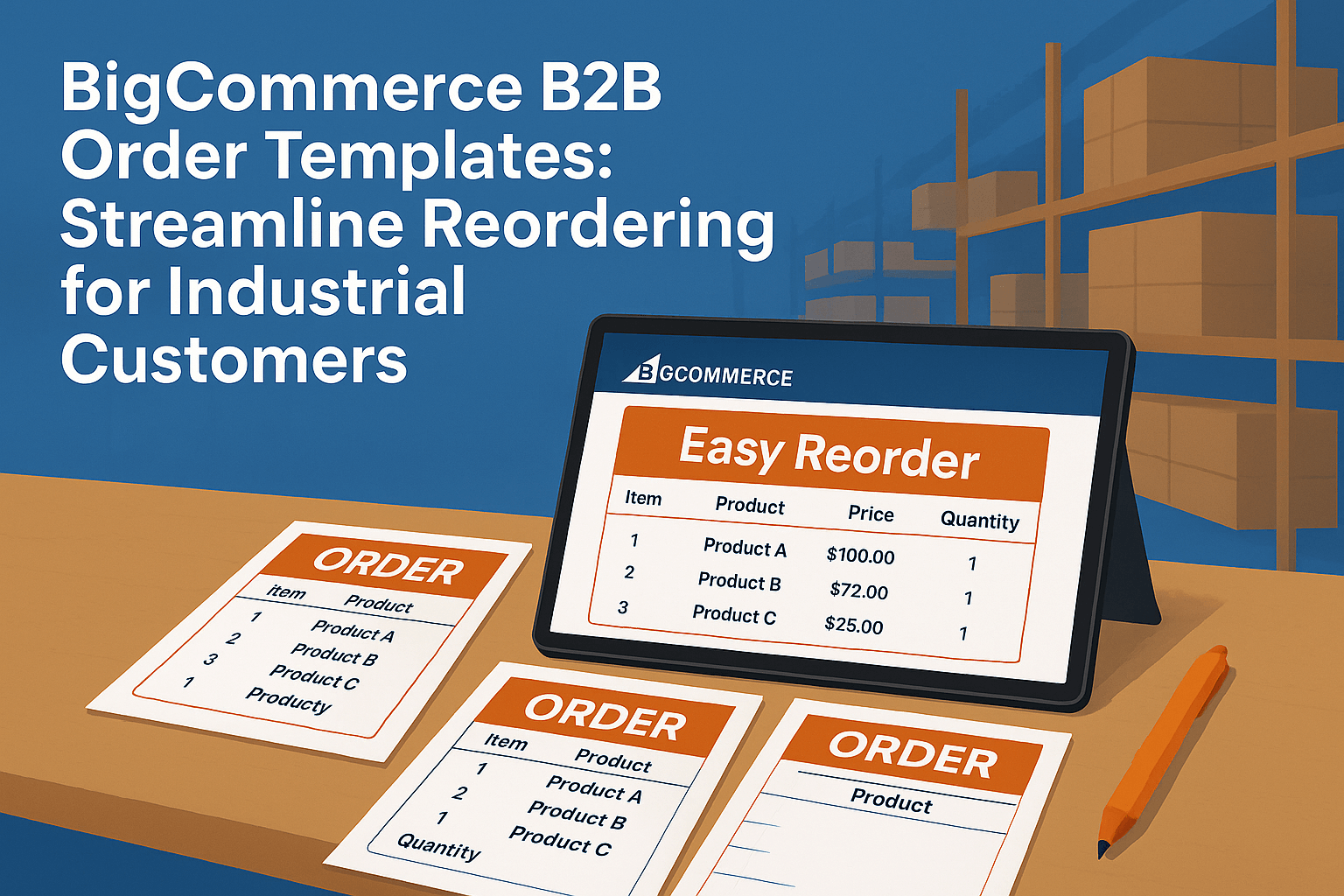The Procurement Bottleneck You’re Not Seeing
Reordering should be the easiest part of selling products online—especially when the customer already knows what they need. They’ve bought it before. There’s no education, no comparison, no risk. And yet, this is exactly where most industrial e-commerce platforms create the most friction.
Here’s what happens in the real world: a buyer logs into your site not to browse but to restock. The buyer logs in with the same SKUs, the same quantities, and the same delivery location. This is a repeat execution. But instead of starting with a preloaded template or saved order set, they’re dropped into a blank catalog and forced to search, click, filter, and rebuild everything from scratch.
That’s where the bottleneck lives. It’s not in load speed. It’s not in navigation. It’s forcing experienced buyers to rebuild the same order again and again, wasting time and introducing the exact kinds of errors procurement systems were designed to prevent.
Every extra step is a chance for something to go wrong. A part number could be overlooked. An inaccuracy in the part number could lead to a mismatch in size. The SKU may be outdated. If one wrong item holds up a job site or delays maintenance, the cost isn’t just inconvenience—it’s downtime.
And from your side? That buyer likely represents one of your most valuable segments. They’ve already placed orders. They’re not price shopping. They’ve chosen you. But instead of rewarding their loyalty with efficiency, you’re giving them a full catalog and asking them to start over.
Reordering shouldn’t feel like rework. If your platform can’t recognize a repeat buyer and streamline the experience accordingly, you’re not just slowing them down, you’re giving them a reason to explore alternatives.
The truth is straightforward: if a customer makes multiple purchases from you, they should not have to manually recreate their order each time. Every time they do, your system gets in their way.
Perfecting the Repeat Purchase
Industrial procurement isn’t creative. It’s procedural. The buyers aren’t browsing because they’re curious—they’re working through a job list. Their focus is not on exploration; it is on execution. And every extra minute spent clicking through filters or re-entering SKUs is a minute stolen from something else that actually moves their work forward.
What they want is simple: a fast, reliable, repeatable way to place the orders they already know they need. Not from scratch. They do not want to place orders from memory. The system operates from a previously saved state. They can rely on, repurpose, and modify it without causing any disruption.
A proper reordering system isn’t just about convenience. It’s about aligning with how procurement already functions: creating internal processes, minimizing human error, and accelerating throughput. These buyers aren’t thinking in SKUs, they’re thinking in jobs, site lists, and standardized bundles.
Give them the ability to save a group of SKUs under a name that means something to them—like “Q2 Maintenance Restock” or “Line 4 Tooling Kit”—and now they’re working in their own language. Let them adjust quantities without losing the base template, and now they’re moving at speed. Let them duplicate a prior order, update delivery details, and assign it to another location—and suddenly your platform fits into how their organization actually buys across teams and geographies.
And don’t make them scroll through past orders or scrape spreadsheets to build it again. They’re not here to shop—they’re here to restock. If you treat their repeat business like it’s a brand-new transaction every time, you’re forcing friction into a process that should be optimized and invisible.
Industrial buyers want fewer clicks. Fewer decisions. Fewer chances to get it wrong. They want systems that remember their needs, support their structure, and accelerate their tasks.
In short, they want a reorder system that doesn’t waste their time.
Where Most Platforms (Including BigCommerce) Fall Short
Most e-commerce platforms weren’t built for industrial reordering. They were built for one-off transactions—add to cart, checkout, done. That works fine for consumer sales or even simple B2B transactions. But it completely breaks down when the buyer needs to order the same 27 SKUs every two weeks, with exact specifications, line items, and delivery expectations that never change.
BigCommerce is no exception. Out of the box, it gives you some basic tools: order history, saved carts, and a “Buy Again” button on product pages. It’s enough to check a box. But not enough to support serious procurement.
Let’s start with saved carts. They aren’t designed for template use. They don’t allow naming or categorizing. There’s no way to track which user saved what, no internal labeling like “Q4 Facility Supplies,” and no access control. If a buyer creates one, it sits in their account—buried, unstructured, and tied to a single login. There’s no logic for versioning, no way to duplicate and edit without overwriting, and no link to other users within the same customer account.
Order history isn’t much better. It assumes the buyer will remember what they ordered last time, navigate to that invoice, then re-add everything manually, or hope the “Buy Again” widget shows the right SKU. It’s reactive. There’s no way to proactively build and manage a repeatable list that can be shared across locations, adapted for quantity changes, or aligned to budget cycles.
BigCommerce B2B Edition adds some improvements—custom pricing, shared customer accounts, requisition lists—but even those features feel bolted on. They don’t enforce logic, they’re not integrated into workflows, and they lack the structure to scale. They assume a linear process. Industrial procurement is rarely linear.
And what happens when something changes? Pricing shifts. Inventory adjusts. If your templates are static—just saved versions of yesterday’s cart—you’re exposing the buyer to outdated information. Now they don’t trust the system. They email instead.
That’s the real risk: if the reorder tools don’t meet the operational bar, the customer stops using them. And when that happens, your platform becomes just another storefront they visit occasionally, while the real ordering happens through reps, spreadsheets, or someone else’s system.
Beyond Order Form Templates—What Real B2B Reordering Looks Like
A real template system doesn’t start with features—it starts with how industrial buyers actually work. It’s not about giving them a cart they can save. It’s about giving them a framework that supports repeat purchasing, shared operational logic, and a scalable purchasing process across locations, teams, and timelines.
At its core, a real B2B order template system does three things: it remembers what matters, adapts to change, and reduces the margin for error.
First, it must allow buyers to create named, persistent templates, not saved carts, not wishlists. These templates can be labeled clearly and used repeatedly. A maintenance manager should be able to save a set of 42 SKUs under “Monthly Service Kit – Site B,” and trust that it’s there, intact, every time.
Second, the system should support role-based access and visibility. Not every user at the company needs to see every template. Branch managers should only see what’s relevant to their team. Procurement leads at HQ should see everything—and be able to lock certain templates as “standard issue” to avoid local customization.
Third, templates must be editable without being fragile. A buyer should be able to adjust a quantity, swap in a replacement SKU, or duplicate the whole list for a new job site without overwriting the original. And every version should pull live product data—price, inventory, lead time—so the buyer always sees what’s actually available now, not what was available three months ago.
Templates also need to be shareable within the organization. A branch manager builds a reorder set, and their team sees it immediately. There should be no need for file sharing, exporting, or a manual setup. Just visibility and reuse.
And above all, the system needs to offer a clean transition from template to transaction—including support for approvals, quotes, and online payments—so the process remains seamless from start to finish. One click should push the full list into the cart. If approvals are required, the system should route the cart directly into the approval workflow—no re-entry, no duplication. This isn’t just convenience. It’s how enterprise procurement avoids unauthorized spending and keeps orders traceable.
At scale, templates not only provide assistance but also serve as crucial infrastructure. Without them, every reorder becomes a risk: a new chance to get something wrong, slow the process down, or lose the customer’s trust.
A real template system doesn’t make reordering easier. It makes it invisible.
Building Template Logic on Top of BigCommerce
BigCommerce doesn’t give you true B2B order templates out of the box—but it gives you the flexibility to architect a solution that supports real digital transformation in industrial ecommerce. Especially when paired with a headless architecture, BigCommerce becomes a powerful backend engine—letting you build the exact reorder experience your customers need without being boxed in by default storefront limitations.
The key is to treat templates as structured data, not as leftover carts or order history. That means storing templates outside the cart system entirely—ideally in a custom app or middleware layer that communicates with BigCommerce via API. Each template becomes a saved set of product IDs, quantities, customer contact information, and metadata—tailored to the company’s unique business needs and tied to their account, not just a user
Start by using BigCommerce’s Customer Groups and Company Accounts as the anchor. These allow you to assign templates to the right organization and control access by role or user. Every template is stored in your external database and linked back to the BigCommerce Customer ID or Company ID.
Then, build a “My Templates” dashboard in the customer portal. This is where buyers can:
- View all templates they have access to.
- Create new ones by saving a cart or selecting from order history.
- Duplicate existing templates for different jobs or branches.
- Rename, update, or delete templates they own—without touching the original.
- Launch a template directly in the cart or submit it to an approval workflow.
To keep things live, sync product data via the BigCommerce Catalog API rather than duplicating values. That way, if a product becomes unavailable or pricing changes, the system reflects that immediately. When the buyer loads a template, your middleware fetches current pricing, inventory, and lead times in real time—eliminating trust issues and reducing dependency on support.
You can also build in template-to-quote workflows, where templates become the starting point for sales-assisted quoting. A buyer saves a template and sends it for review, and your team turns it into a negotiated quote, all inside the same system.
For larger customers, integrate template logic with branch-level controls: show only relevant templates to each team based on branch ID, project code, or role. And if you’re already using an ERP or procurement suite, pipe template metadata into those systems for consistency and reporting.
The goal is to make templates feel native—even if the logic isn’t. The user shouldn’t care whether the data lives in BigCommerce or not. All they know is that their templates are there, they’re accurate, and they work.
This is what separates a slapped-on plugin from a real operational tool: it respects the buyer’s process, and it’s built around how they actually reorder—at scale.
How Smart E-commerce Changes Reordering at Scale
When reordering works the way it should, everything downstream gets easier. You don’t just make the process faster; you change how your customers interact with your business.
While online order forms provide a transactional shortcut, they don’t offer the structure, control, or repeatability industrial buyers depend on.
The most obvious impact is time. The process of catalog navigation and line-by-line SKU entry, which previously took 30 minutes, now takes less than two. That’s not a marginal improvement; it’s a structural one. Procurement teams that place five, ten, or even fifty reorders a month quickly accumulate significant time savings.
That time savings also translates directly into reduced error rates in customer orders—fewer wrong SKUs, fewer mis-shipments, and less rep intervention. When buyers don’t have to re-enter part numbers, search manually, or piece orders together from old invoices, the risk of picking the wrong SKU drops significantly. And fewer errors mean fewer returns, fewer support tickets, fewer order delays—and far less rep intervention.
It also restores trust in the system. When templates behave consistently—loading the right data, reflecting live availability, and pushing cleanly into checkout—buyers stop second-guessing what they’re doing. They don’t call your team to verify part numbers. They don’t email their rep to double-check a bundle. They just place the order and move on.
Sales teams benefit too. When templates are in place, they’re no longer spending hours a week building carts for customers. They’re not manually duplicating old orders. They’re focused on upsell conversations, contract renewals, and problem-solving that actually moves revenue—not backfilling for a broken workflow.
You also get better data. Templates let you track repeat purchasing behavior with clarity: what items are reordered most often, by whom, and for what purpose. That data gives you leverage for forecasting, discounting, and operational planning. Without templates, freeform cart behavior and duplicated effort bury that signal.
Finally, a strong reorder experience makes you harder to replace. If the customer has structured their workflows around your system—using your templates, your naming conventions, and your saved sets—you’re no longer just one of many suppliers. You’ve become the infrastructure. The switching cost rises—not because you’ve locked them in, but because you’ve actually solved their process.
And in B2B, that’s the difference between a vendor and a partner.
Why a Basic Online Order Form (or Saved Cart) Isn’t Good Enough
If your reordering system is just a renamed “Save Cart” button, you’re not helping your customers—you’re creating a fragile workaround that breaks under real operational pressure.
The first failure is technical. Saved carts in BigCommerce are not built to persist across catalog changes. If inventory levels shift, products are retired, or pricing updates, the cart may break—or worse, silently load with outdated data. For industrial buyers managing regulated environments or tight procurement specs, that’s a risk they can’t take.
The second failure is structural. Saved carts are flat. There’s no way to organize them. No custom naming. No grouping by project, department, or facility. They exist as loose records, with no search function and no ability to categorize. When a buyer manages multiple jobs or teams, scrolling through an undifferentiated list of generic saved carts is as bad as rebuilding from scratch.
Another area of concern is access control. Most platforms treat saved carts as user-level objects—tied to a login, not a company. That means if a buyer leaves the organization or forgets their credentials, every saved reorder list disappears with them. There’s no handoff, no reassignment, and no visibility for other team members. You’re forcing corporate customers to rely on screenshots and spreadsheets because your system doesn’t recognize shared workflows.
Then there’s the lack of modularity. Need to duplicate a saved cart and tweak one line item? You’re starting over. Need to combine elements from two saved orders into one? No support. Need to lock down a template as “standard” for your team? No versioning, no approval routing, no naming convention enforcement.
And finally, the biggest issue: saved carts don’t reflect the way procurement works. They’re a leftover consumer feature rebranded for B2B. In reality, industrial customers operate from templates, BOMs, replenishment schedules, and project-driven lists—not impulse carts they happen to re-use. When your system doesn’t map to that logic, you’re forcing buyers to translate their workflow into your limitations.
That disconnect creates friction. And friction is what sends them back to email, to reps, or to platforms that offer real structure.
The takeaway is clear: “Save Cart” might seem like a helpful shortcut—but it’s a stopgap, not a system. If you want to be the platform they trust to run repeat business, you have to give them something built for it.
BigCommerce B2B Order Template Toolkit
Template Logic Blueprint
Stop treating reorders like one-off carts. Start thinking in reorder frameworks.
Core Template Logic Model:
| Element | Description | Example |
| Template Name | Operational context—not SKU-related | “Q3 Line 6 Maintenance Kit” |
| Customer Company ID | Tied to BigCommerce Company Account | company_473_houston |
| User Role Access | Role-based visibility and permissions | “Maintenance Lead” (read/write), “Purchasing Admin” (lock) |
| Template Type | Identifies operational use | Standard Issue / Personal / Location-Specific |
| SKUs & Quantities | Structured list of line items | JSON or DB reference, not hardcoded |
| Last Synced | Last time price/inventory was validated | Sync daily via Catalog API |
| Editable Fields | Allowed per user role | Qty, ship-to, swap SKU under constraints |
“My Templates” Dashboard Requirements
This isn’t fluff—it’s the command center for high-velocity buyers.
| Feature | Why It Matters |
| Named Templates | Buyers think in job kits, not SKUs |
| Role-Based Views | Team-level clarity, no clutter |
| Template-to-Cart/Quote | No re-entry. One-click action |
| Duplicate + Edit | Don’t overwrite—version it |
| Share Within Org | Procurement isn’t a solo sport |
| Live Data Sync | Prices, inventory, lead times always fresh |
Template Error-Proofing Rules
| Scenario | Smart System Behavior |
| SKU retired | Warn + recommend replacement SKU |
| Price changed | Auto-refresh on template open |
| Out-of-stock | Alert + suggest ETA or alt |
| Restricted user | View-only or no access |
| Duplicate template name | Prompt for rename or version tag |
Technical Stack Guidance
| Layer | Tool | Role |
| Middleware/DB | Firebase / Supabase / Postgres | Template logic + versioning |
| Frontend UI | React (Headless BC) | “My Templates” interface |
| Sync Layer | BigCommerce Catalog API | Real-time pricing, inventory |
| Checkout Integration | Cart API / Quote API | Push template into transaction |
| ERP Bridge (Optional) | Zapier / Custom API | Pipe order data downstream |
Time & Risk ROI Model
| Before Templates | After Templates |
| 27 SKU order = 30 min | 2 min repeat reorder |
| SKU error every 10 orders | 80–90% reduction |
| 5+ support emails / week | 0–1 rep touchpoints |
| Buyer rebuilds each time | Buyer reuses & updates |
| Low trust in catalog | High confidence in system |
Behavior Tracking for Forecasting & UX
| Data to Track | Use |
| Most-used templates per account | Suggest bundling, promos |
| SKU dropout (removed before checkout) | Flag friction in config |
| Quantity changes vs. original | Identify seasonal shift or substitution needs |
| Cross-user usage patterns | Improve visibility logic |
| Template abandonment rate | UX performance metric |
Build Checklist for Dev Teams
| Task | Status |
| Middleware DB for templates ☐ | |
| Template creation UI (w/ name, tags, save logic) ☐ | |
| “My Templates” dashboard per role ☐ | |
| Catalog API sync logic (price, inventory) ☐ | |
| Push-to-cart / push-to-quote integration ☐ | |
| Role-based template visibility filters ☐ | |
| Approval routing logic (if required) ☐ | |
| ERP/CRM pipe (optional but ideal) ☐ |
Templates are not a feature. They’re your buyer’s second brain.
Build them like infrastructure, not convenience.
Templates Are the Shortcut to Becoming Essential
B2B customers don’t stay loyal because of your price or catalog depth. They stay because your system makes their process easier. And nothing makes that more visible than templates that actually work.
When you give repeat buyers the ability to create structured, shareable, editable order sets, you’re not just saving them time. You’re embedding yourself in how their team operates. You’re streamlining the process for every future purchase. You’re making it harder for them to imagine going elsewhere, not because you’ve trapped them, but because you’ve delivered clarity, speed, and reliability where they need it most.
Templates aren’t just a feature. They’re a trust-building mechanism. Every time a buyer logs in and sees their templates exactly where they left them—accurate, current, and ready to go—you reinforce that trust. Every order placed in under two minutes is another reason for procurement to keep you as the preferred supplier.
BigCommerce does not provide this functionality by default. But it gives you the infrastructure to build it, and the flexibility to do it right. If you treat templates like operational tools, not marketing features, you’ll separate yourself from every competitor still relying on saved carts and manual quotes.
Because in the end, the question isn’t whether your site can handle reorders.
It’s whether your customers would ever want to reorder without it.
If your B2B buyers are still rebuilding the same orders every month, you’re not just losing efficiency—you’re risking retention. We build custom order templates BigCommerce that actually reflect how industrial procurement works.
Contact us to discover how we can transform your store into a reordering engine that your customers will depend on and that your competitors cannot replicate.











